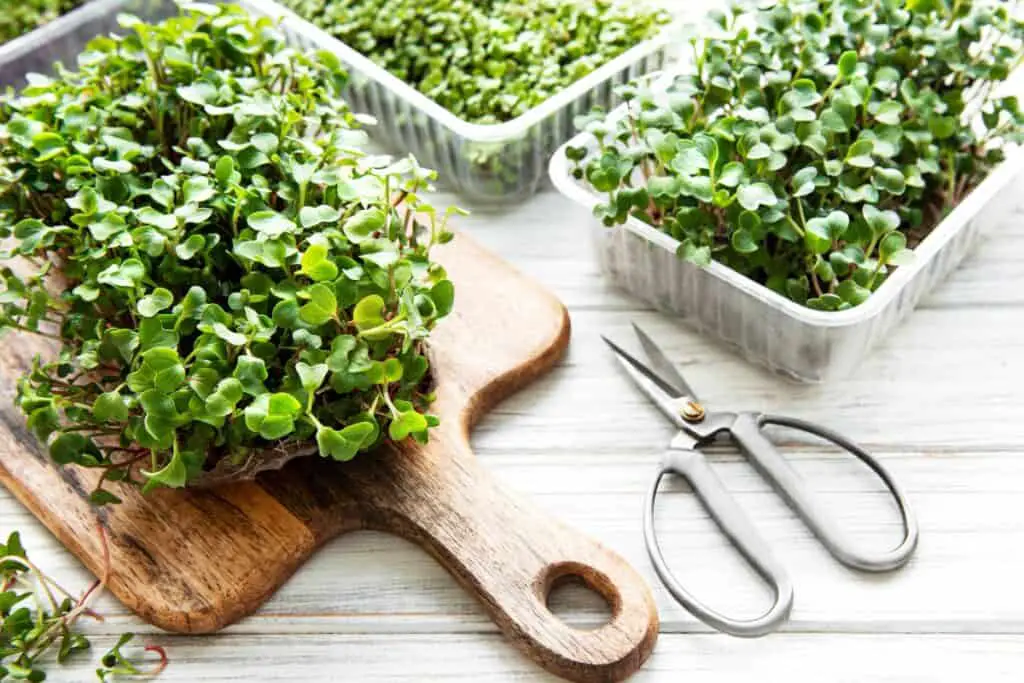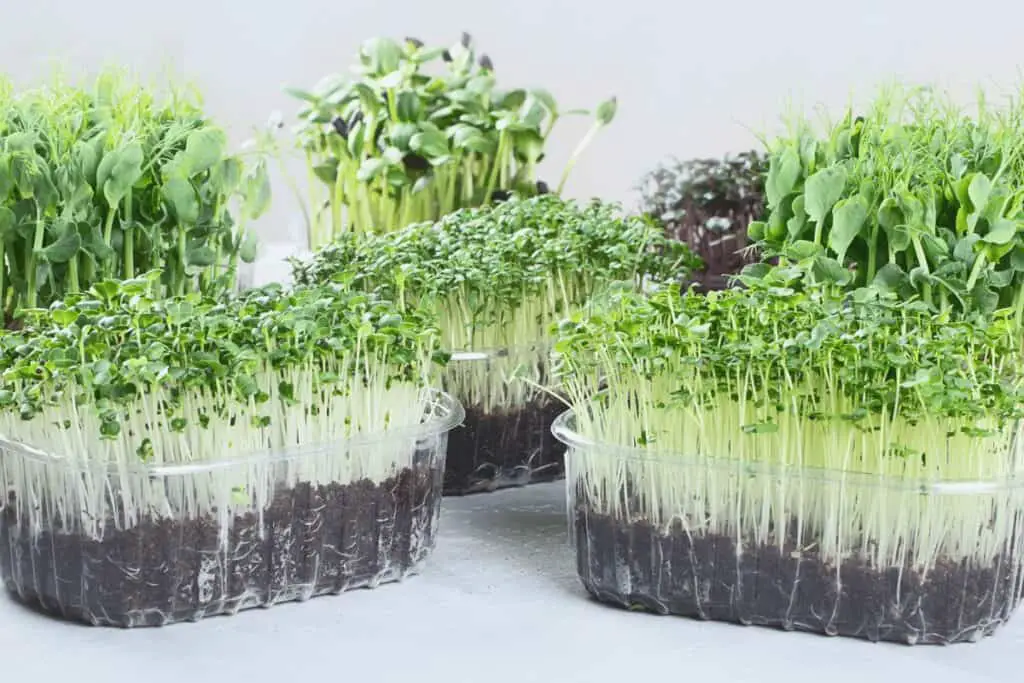Microgreens have taken the culinary world by storm, bringing vibrant colors, intense flavors, and a nutritional punch to dishes. These tiny greens are harvested just after the emergence of their first true leaves and have gained popularity for their visual appeal, distinctive taste, and health benefits.
In this article What is a microgreen true leaf, we will explore the world of microgreens, discover their various types, learn how to grow them at home and uncover their nutritional value. So, let’s dive in and explore the wonderful world of microgreens!
Introduction
Microgreens are young vegetable greens that are harvested when they are only a few inches tall, typically within 7 to 14 days after germination. They are not the same as sprouts or baby greens. Instead, they are the stage between sprouts and baby greens, characterized by the development of their first true leaves.
These tender and flavorful greens are packed with nutrients, making them a popular choice for health-conscious individuals and culinary enthusiasts alike.
What are Microgreens?
Microgreens are essentially the miniature versions of full-grown plants, with concentrated flavors and vibrant colors. They are grown from a variety of vegetable, herb, and flower seeds, including arugula, kale, radish, basil, and sunflower, to name a few. When harvested, microgreens consist of a tender stem, cotyledon leaves, and the first set of true leaves.
These leaves offer a distinct flavor profile that can range from mild and nutty to spicy and tangy, depending on the variety.
Why Are Microgreens Popular?

The popularity of microgreens stems from their unique combination of visual appeal, intense flavors, and nutritional density. Their delicate and intricate structures, often displaying a range of colors, make them an attractive garnish or ingredient in various dishes.
Furthermore, microgreens pack a concentrated punch of flavors, adding a burst of taste to salads, sandwiches, soups, and even main courses. Their growing popularity can also be attributed to the increasing interest in healthy eating and the desire to explore new culinary experiences.
Different Types of Microgreens
Microgreens come in a wide range of varieties, each offering its own distinctive taste and appearance. Here are some of the most common types of microgreens:
Leafy Greens
Leafy greens like spinach, kale, and lettuce are popular choices for microgreens. They add a fresh and vibrant touch to dishes and are packed with essential nutrients like vitamins A, C, and K.
Brassicas
Brassicas, such as broccoli, cabbage, and radish, are known for their slightly spicy and peppery flavors. They are rich in antioxidants and provide a good amount of dietary fiber.
Herbs
Microgreens of herbs like basil, cilantro, and parsley bring the essence of their mature counterparts to dishes. They provide a burst of aromatic flavors and are often used as a finishing touch.
Edible Flowers
Certain flowers like nasturtium, marigold, and borage can be grown as microgreens. These delicate and colorful blooms add a touch of elegance and a subtle floral note to culinary creations.
Other Varieties
Microgreens are not limited to greens and herbs. There are other varieties available, including amaranth, sunflower, chard, and beets. Each variety offers its own unique taste profile and nutritional benefits.
How to Grow Microgreens

Growing microgreens at home is a rewarding and relatively simple process. Here are the steps to get started:
Choosing the Right Seeds
Select high-quality seeds specifically labeled for microgreen production. Consider factors such as taste preference, growth rate, and ease of cultivation.
Preparing the Growing Medium
Prepare a shallow container or tray with a well-draining growing medium, such as potting soil or coconut coir. Ensure the medium is moist but not waterlogged.
Planting and Germination
Spread the seeds evenly over the prepared growing medium, ensuring they are not too crowded. Lightly press the seeds into the surface and cover them with a thin layer of soil or vermiculite. Mist the surface with water and cover the container with a clear lid or plastic wrap to create a mini-greenhouse effect. Place the tray in a warm and well-lit location, away from direct sunlight.
Caring for Microgreens
Keep the growing medium consistently moist by misting it regularly with water. Avoid overwatering, as it can lead to fungal issues. Provide ample indirect sunlight or artificial light to promote healthy growth. Maintain good airflow by occasionally removing the cover to prevent mold or fungal growth.
Continue watering and caring for the microgreens until they reach the desired height and their true leaves have developed.
Harvesting Microgreens
Microgreens are typically ready for harvest within 7 to 14 days, depending on the variety. Once the true leaves have fully developed, use clean scissors or a sharp knife to cut the greens just above the soil level.
Rinse them gently to remove any soil particles and pat them dry. Freshly harvested microgreens can be stored in airtight containers in the refrigerator for a few days.
Nutritional Benefits of Microgreens
Despite their small size, microgreens pack a nutritional punch. They are rich in vitamins, minerals, antioxidants, and enzymes. The nutrient content varies depending on the type of microgreen, but they generally provide a concentrated source of nutrients, including vitamins A, C, and K, as well as folate, iron, and potassium.
Incorporating microgreens into your diet can help enhance overall nutrient intake and support a healthy lifestyle.
Culinary Uses of Microgreens
Microgreens offer a versatile ingredient for culinary exploration. They can be used in various ways, including:
- Garnishing salads, soups, and sandwiches
- Adding a pop of color and flavor to omelets and scrambled eggs
- Topping pizzas, tacos, and burgers for an extra burst of freshness
- Blending into smoothies for added nutrients
- Incorporating into stir-fries and pasta dishes
- Pairing with cheese, seafood, or roasted vegetables for a visually appealing appetizer or side dish
The possibilities are endless, allowing you to get creative and experiment with different flavor combinations.
Microgreens and Sustainability
Microgreens are not only nutritious and delicious but also environmentally friendly. They require less space, water, and time to grow compared to their mature counterparts. Additionally, they can be grown indoors year-round, making them accessible even in urban settings.
Incorporating microgreens into your diet can contribute to a more sustainable food system by reducing the carbon footprint associated with traditional agriculture and transportation.
Health and Safety Considerations
While microgreens are generally safe to consume, it’s essential to follow proper hygiene and food safety practices. Here are a few considerations:
- Start with clean and sanitized containers, tools, and growing mediums.
- Use organic or pesticide-free seeds to minimize the risk of chemical residues.
- Avoid consuming microgreens if they show signs of spoilage, mold, or an off odor.
- If you have any underlying health conditions or allergies, consult with a healthcare professional before incorporating microgreens into your diet.
Where to Buy Microgreens
Microgreens are becoming increasingly popular and can be found in various places. You can explore the following options:
- Local farmers’ markets: Many local farmers and vendors offer fresh microgreens at farmers’ markets, allowing you to support local agriculture.
- Specialty grocery stores: Some grocery stores have dedicated sections for microgreens, offering a variety of options.
- Online retailers: Numerous online platforms and websites specialize in delivering fresh microgreens to your doorstep, providing a wide range of choices.
Frequently Asked Questions
Can I grow microgreens without using soil?
Yes, microgreens can be grown hydroponically using materials like vermiculite, coconut coir, or water-soaked paper towels as a growing medium [1].
Are microgreens more nutritious than fully-grown vegetables?
Microgreens are more concentrated in nutrients compared to mature vegetables. Studies have shown that they can contain higher levels of vitamins and beneficial compounds [2].
How long do microgreens last after harvest?
Freshly harvested microgreens can be stored in the refrigerator for a few days, but it’s best to consume them as soon as possible to enjoy their optimal freshness and flavor.
Can I freeze microgreens for later use?
Freezing microgreens can affect their texture and flavor. It’s recommended to consume them fresh or store them in the refrigerator for short periods.
Are all microgreens safe to eat?
While most microgreens are safe to consume, some varieties may have potential toxicity or allergic reactions. It’s essential to research and ensure the safety of the specific microgreens you choose to grow or consume.
Conclusion ~ What is a microgreen true leaf
Microgreens offer a delightful and nutritious addition to any meal. These miniature greens bring an explosion of flavors, colors, and nutrients to the plate. Whether you grow them at home or purchase them from local markets, microgreens provide an opportunity to elevate your culinary creations while supporting a sustainable and healthy lifestyle.
So, embrace the world of microgreens and let their true leaf beauty enhance your dining experience!





2 responses to “What Is a Microgreen True Leaf”
[…] specifically labeled for microgreen production. Consider the flavor, color, and growth cycle of the microgreens you wish to […]
Thank you